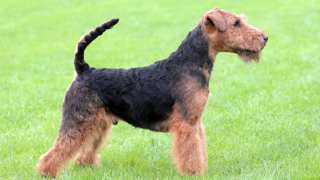Stripping a Westie tends to be a time-consuming task, but it's only needed a couple times a year or before a dog show. Stripping will literally strip away the outer coat by its roots so a fresh new one grows in. Stripping will create a vibrant, colorful and crisp new coat. To test the coat to see if it's ready for stripping, use your forefinger and thumb to pull — not yank! — in the direction of the hair growth. If the hair comes out easily, it's time to strip. Summertime will require a bit more stripping.
There are not only specific tools for stripping but tools specific to the breed being stripped. For a West Highland White Terrier, many groomers might recommend the Double-wide Mars Coat King 23-blade. No matter what kind of blade you use, the duller it is, the better. It must be used with the lay of the hair or it will cut the hair — which you don't want. Cutting or trimming the hair will make the coat dull.
Hand-stripping a Westie is when you don't use a blade but literally use your hand to pull the hairs from the coat. This procedure is best done over time, and it may take several weeks to hand-strip the entire coat.
Once the overcoat is stripped, some people will continue on to carding. Carding is the removal of dead undercoat hair. Like stripping, it is quite the task. Using any one of a number of tools that will casually grasp and extract the dead hair can be used: pumice stones, a lava rock from the garden, shedding blades, stripping knives or any old, dull blades originally meant for large, coarse hair. You don't want to cut the hairs, however, and you will want to see how it's done by a pro first so you can learn how to drag out the dead hairs.
When it comes to plucking, there remains a debate. Some people insist that plucking hairs from a dog's ears leave microscopic wounds that allow bacteria to collect and sores to form. Others state that certain dogs, like Westies, have such thick inner-ear hair that, when their ears flop down, the unplucked hair creates severe health problems. If you decide to pluck your Westie's ears, you should do so carefully. Be sure to gently clean and dry afterward. Use mineral water for cleaning and vet-approved cotton balls for drying.







